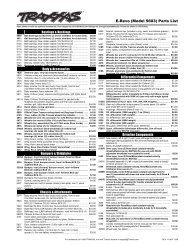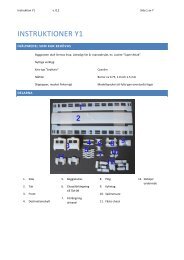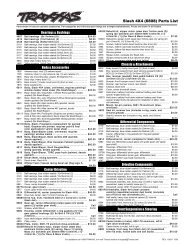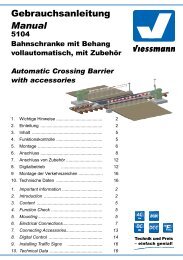ESU 51982 Manual Engelska
ESU 51982 Manual Engelska
ESU 51982 Manual Engelska
Create successful ePaper yourself
Turn your PDF publications into a flip-book with our unique Google optimized e-Paper software.
Programming<br />
8. Decoder Settings (Programming)<br />
Chapter 8 covers setting various parameters of the LokPilot decoder.<br />
Should you not be familiar with the handling of CVs please take<br />
the time to read these occasionally quite complex instructions.<br />
After an introduction into the world of parameters in chapter 8.1,<br />
we explain in the following section 8.2 how to change various<br />
parameters in DCC mode and with Märklin® central units.<br />
The chapters 9 to 16 explain which parameters have what kind of<br />
influence on the behaviour of the LokPilot decoder.<br />
8.1. Adjustable Properties of Decoders<br />
The hardware determines some features such as the number<br />
of function outputs as well as the maximum permitted current<br />
of the motor output and therefore they are not programmable.<br />
Nevertheless, there are plenty of possibilities to influence the behaviour<br />
of the LokPilot decoder by adjusting software-governed<br />
properties.<br />
There is at least one memory space within the decoder reserved<br />
for each adjustable parameter where numbers or letters can be<br />
stored.<br />
You could visualize the storage spaces as index cards in a large file<br />
box. In order to enable you to find the right card again, they all<br />
have numbers and / or names outlining the properties of this particular<br />
card such as „locomotive address“ or „maximum speed.“<br />
Then imagine that you can write information onto these cards. Adjusting<br />
the settings means nothing else but erasing one entry and<br />
replacing it with another. Moreover, you could do that at any time.<br />
However, you cannot write onto every card: some bits of information<br />
like the manufacturer’s code are firmly encoded.<br />
Thus, you can determine the content of the storage spaces in the<br />
decoder even during operation and of course, the decoder will follow<br />
the instructions. Via the procedure known as „Programming,“<br />
you can enter the desired data into the storage spaces.<br />
8.1.1. Configuration Variables (CVs)<br />
LokPilot V4.0<br />
LokPilot micro V4.0<br />
LokPilot V4.0 DCC<br />
LokPilot micro V4.0 DCC<br />
LokPilot decoders follow the CV concept developed in the US. CV<br />
stands for „Configuration Variable“ and indicates that the storage<br />
cells described above are not only variable but they also determine<br />
the behaviour of the decoder.<br />
8.1.1.1. Standardisation in the NMRA<br />
The NMRA (National Model Railroad Association) has defined<br />
which CVs determine certain parameters of a decoder. The DCC<br />
standard allocates fixed numbers for certain CVs (adherence is<br />
obligatory). This greatly simplifies things for the user since decoders<br />
of most manufacturers comply with this standard and therefore<br />
dealing with CVs requires the same process with the same<br />
CV-numbers regardless of the manufacturer.<br />
The DCC concept permits to enter numbers ranging from 0 to 255<br />
into CVs. Each CV carries only one number.<br />
While the position number is predetermined, the range of values<br />
may vary. Not all CVs must accept values ranging from 0 to 255.<br />
The permitted values for LokPilot decoders are listed in the table in<br />
chapter 20.1. showing all available CVs.<br />
23












